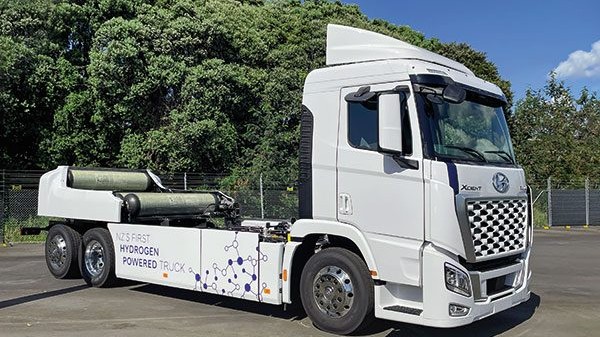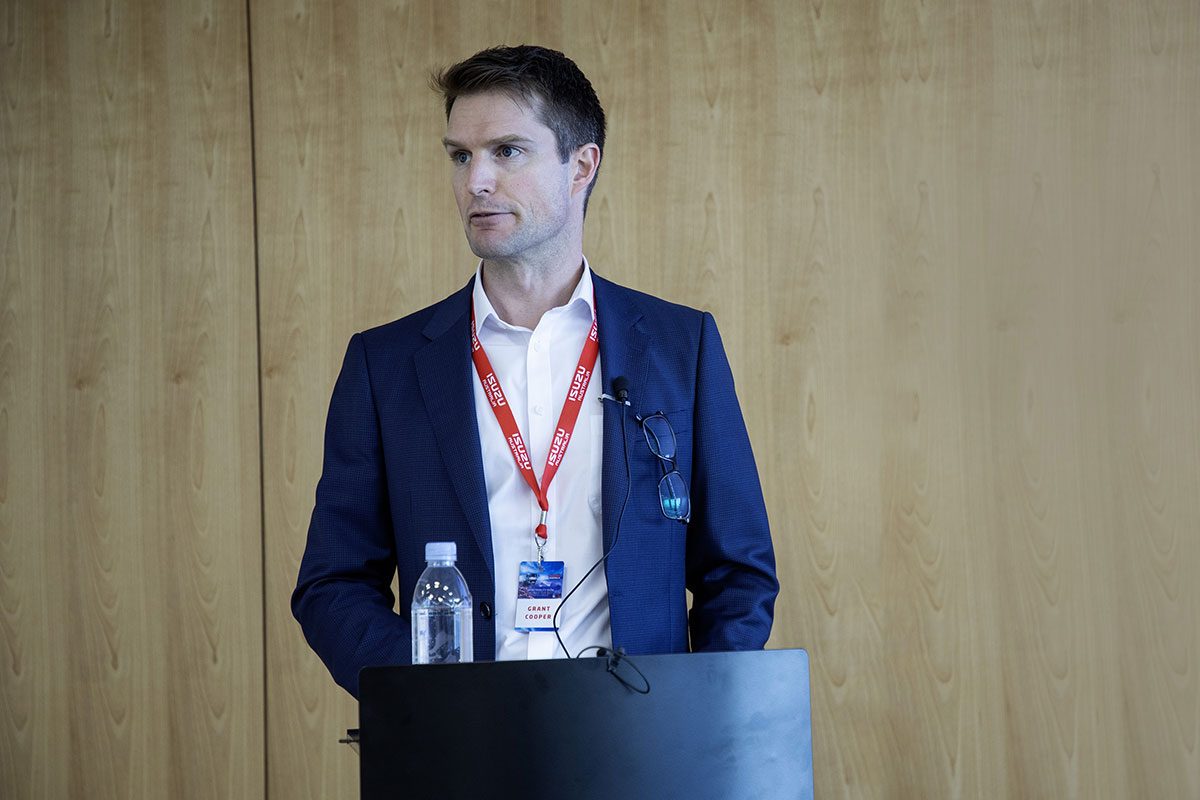Hyundai’s Hydrogen Heavy is here

It’s a reflection of New Zealand’s commitment to alternative fuels that our tiny market has the distinction of being just the third, after Switzerland and Hyundai’s homeland of South Korea, to get the hydrogen-powered Hyundai Xcient FCEV. We got to see it up close and learn of Hyundai’s plans.
For the past 22 years, Hyundai has invested in and developed its hydrogen technology and roadmap-to-the-future portfolio of environmentally friendly vehicle solutions. Since 1998, it has invested more than US$9.8 billion (about $14.5 billion) in technology, talent, design and business partnerships.
The result has been numerous battery and hydrogen fuel-cell-powered electric vehicles across its passenger car and commercial vehicle range. The company’s first commercially available truck is this, the Xcient FCEV.
Andy Sinclair, CEO of Hyundai Motors New Zealand, says Hyundai has decided to start its large- scale commercialisation of hydrogen vehicles with commercial vehicles. Hyundai plans to be the first global manufacturer to apply fuel- cell technology across all its commercial vehicles by 2028, he says.
 An engine? No, the hydrogen fuel-cell stack.
An engine? No, the hydrogen fuel-cell stack.
“These are large emitters of CO 2 . Hyundai believes using hydrogen and electric vehicles across all forms of transport will make the biggest impact in the shortest time. Vehicles move more freight and cargo than they do people, so by concentrating on vehicles that carry freight or move lots of people at once, we can do the most good in the shortest time as the technology continues to evolve.
“In New Zealand, heavy transport makes up 4% of the national fleet and is responsible for 25% of transport emissions, so for us, it’s a great place to start,” Sinclair says. “We will partner with other businesses that share a similar vision and help accelerate the uptake of FCEV technology in New Zealand.”
To make the trial happen, Hyundai New Zealand has partnered with EECA and the New Zealand Hydrogen Council. In April 2022, five Xcient FCEVs will likely be in service.
Hyundai will kick off the programme with Swiss-spec trucks, converted to New Zealand spec. “It’s our full intention to commercialise hydrogen trucks in New Zealand following the trial,” Sinclair adds.
 The electric motor is paired with a six-speed Allison autobox.
The electric motor is paired with a six-speed Allison autobox.
How does it work?
This trial could run for as long as eight to 10 years, says Grant Doull, hydrogen and eco-commercial vehicles manager at Hyundai New Zealand. “We’ll be looking at data for several years to come. Initial learnings from overseas show that maintenance costs are significantly less and maintenance schedules are few, compared with diesel vehicles.”
Doull says that hydrogen is “really the only option for heavy transport, with very fast refuelling, good range and comparatively lightweight (compared with battery electric vehicles) – meaning there’s space for more payload”.
Gavin Young, technical manager at Hyundai New Zealand, adds that it is a great energy carrier once hydrogen is extracted and stored. “It can be used as an energy source and a fuel due to its high energy content based on its weight.”
Like all internal combustion vehicles, all hydrogen FCEVs share the same basic components. The most noticeable are the tanks – seven on the Xcient positioned vertically behind the cab. These hold 31kg of hydrogen at 350 bar. Young explains that there is a series of systems and fail-safes to monitor for leaks. “As soon as a leak is detected, the system will shut down and alert the driver.”
 Xcient FCEV gets some differentiating aesthetic treatment.
Xcient FCEV gets some differentiating aesthetic treatment.
Directly below the cab, where a diesel engine would go, are the two 90kW fuel-cell stacks. These are approximately the same size and output as a Hyundai Nexo passenger car, just upscaled for commercial output (180kW total).
Behind tanks in between the chassis rails is the high- output 350kW, 2237Nm electric motor. Young says a direct conversion would place it equivalent to a 470hp truck. “However, power delivery is totally linear and very different to diesel.” It drives a six-speed Allison automatic transmission and a conventional differential.
Either side of the chassis sits the high-voltage 72kWh battery pack (consisting of three batteries), weighing roughly 220kg. Again, these batteries are about the same size as those for an EV. In the FCEV, the batteries are used to collect surplus energy from the fuel cell and regenerative braking (see sidebar).
Compressed air for the trucks’ suspension and brake systems is supplied by an auxiliary air compressor, while conventional 24V batteries take care of the usual electrical needs. These are charged by the high-voltage system though low-voltage DC converters.
 And so it begins.
And so it begins.
How does it go?
The Swiss-spec Xcients are a typical Euro-type rigid configuration – that is, 6×2 with a steering rear tag axle. As they stand, a 28,000kg GVM and 42,000kg GCM are the workable numbers, though in New Zealand, these figures will be lower due to local road regulations.
“This is a seriously heavy- duty truck,” says Doull. “It has an awful lot of power. As it sits, there is the potential to go on-road at 39 tonnes combined mass.”
Different body configurations will be available, depending on the customer trialling the individual trucks. Doull says Hyundai New Zealand is targeting the freight sector for its high mileage and usage. The 31kg of hydrogen gives the Xcient FCEV a claimed 400km range, meaning it could do Auckland to Palmerston North in one trip. Hyundai claims refuelling time at eight to 20 minutes.
“They’re very quiet- running and vibration- and emission-free… 50-tonnes of CO 2 will be saved per unit per year on 80,000km of use.”
After the formalities, we were able to look over the Xcient FCEV, but unfortunately not drive it yet. At first glance, we could not help but be reacquainted with our previous excellent experiences with the Xcient – our September 2019 test unit, operated by Corey and Mel Randall out of Napier on their PBT contract, and the big yellow February 2021 Top Truck of Foodstuffs contractors Bruce and Linda Hornell.
 The seven carbon fibre tanks hold 31kg of hydrogen at 350 bar.
The seven carbon fibre tanks hold 31kg of hydrogen at 350 bar.
Stepping up into the cab and getting comfy in the hot seat, the well-appointed environs are extremely familiar. But things become a little more intriguing and foreign when you look at the carbon fibre-reinforced hydrogen fuel tanks bolted to the chassis and the extensive plumbing and layout of electrical components between the rails.
Just how revolutionary this technology is to the transport industry became more vividly apparent when Young jumped into the cab, activated the electrons, and drove the virtually silent Xcient in front of the delegation.
There certainly were a few raised eyebrows and excited smiles, probably akin to the facial expressions of the crowd that had gathered to witness the live trials of engineer Robert Stephenson’s mighty Rocket locomotive in 1829.
We certainly were left asking ourselves: have we just witnessed a similar event? One thing is for sure, this Hyundai New Zealand trial of the Xcient FCEV will profoundly impact how future transportation is executed.
CREATING ENERGY FROM HYDROGEN
As detailed in the main story, FCEVs require certain components to work together to create, store and convert electrical energy into kinetic energy.
The fuel cell is the heart of any FCEV. It generates electricity through an electrochemical reaction involving hydrogen and oxygen. There is no combustion.
“Fuel-cell stacks feature a collection of up to 400 wafer- thin fuel-cell plates stacked together. Any size of fuel cell can produce an electrical current – one fuel cell can generate 1V of electricity,” says Young.
A single fuel cell is composed of an anode and cathode separated by a proton-exchange membrane. Hydrogen gas enters on the negative anode side, where the negatively charged electron of the hydrogen molecule separates, forced through the circuit to create the electricity to power the motor or be stored in the lithium-polymer battery. The positive hydrogen proton moves through the membrane to the positive cathode, where it recombines with the electron and added oxygen from the ambient air, creating water molecules and vapour. These are the only by-products of the process.
“There are no moving parts or combustion – just reliable, safe, silent operation,” Young says.
In the Xcient, the batteries act as a buffer to ensure a constant electricity supply to the motor. They’re kept charged up by the fuel cell and the regenerative braking effect of the motor.
“The systems are modular; for more power, add more stacks; for more range, add more tanks,” says Young.





